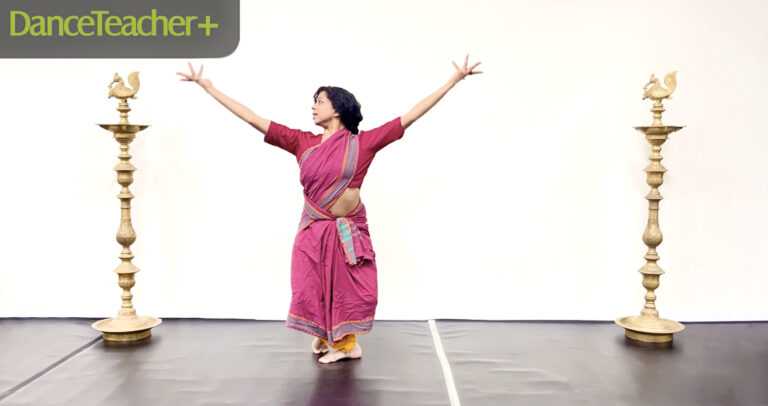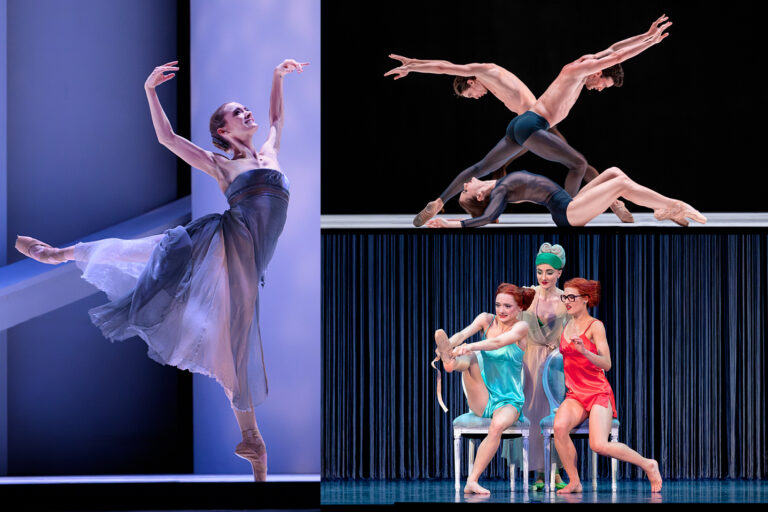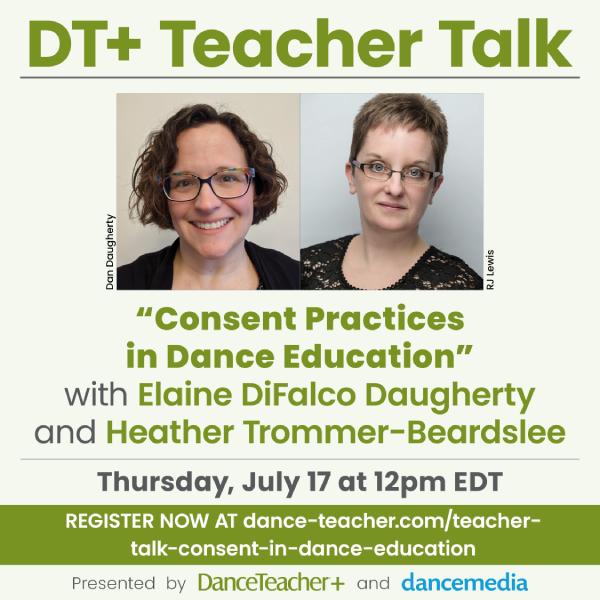On a windy fall morning in a studio at American Ballet Theatre’s Jacqueline Kennedy Onassis School in New York City, Raymond Lukens is gleefully leading a class through barre exercises. The students, who range in age from 22 to 62, listen and laugh as he urges them to make their tendus “more like a nice juicy roast beef than beef jerky.” Two hours of technique later, the students are exhausted but still laughing. And then the real work begins.
The students sprawl out on the floor, notebooks and binders in front of them, as Lukens sits and surveys them. “Tell me how you develop good posture in a child,” he asks. Answers range from “Show the alignment of the body” to “develop the musculature.” But it isn’t until one student says, “Make them feel good about themselves,” that Lukens breaks into a wide smile. “That’s right, it’s all about their state of mind,” he says.
These students are members of a new graduate dance education program that ABT is offering with New York University’s Steinhardt School of Culture, Education, and Human Development. Officially called “Teaching Dance in Higher Education and the Professions: ABT Ballet Pedagogy,” the master’s degree program is the only one of its kind in the country and aims to prepare participants for careers in studios, conservatories, company schools, colleges and universities, as well as further study at the doctorate level. The 21 students in the inaugural class—16 women and five men—spend mornings at ABT taking Lukens’ “Theory and Methodology in Ballet Pedagogy” class, then speed over to NYU to round out their studies with courses like “Principles and Practices of Performing Arts Administration” and “Adolescent Development.” The program requires three full-time semesters, although many of the students hold dance teaching jobs during the evenings and weekends.
The NYU program is just one facet of ABT’s National Training Curriculum, a codified program for the development and training of students that was designed and written by Lukens, artistic associate for the ABT/NYU masters program, and Franco De Vita, principal of the JKO School, in collaboration with a national artistic advisory panel. The impetus for the NTC first grew a couple of years ago, when the ABT staff noticed that dancers at auditions often lacked sufficient technical training and were stylistically inflexible.
“We thought the fastest way to raise the quality of ballet training in this country would be to provide additional training for teachers,” says Rachel Moore, ABT’s executive director. At the same time, she says, the company “wanted to respect that each teacher has his or her own voice and a way of eliciting the best from students.” As De Vita puts it, “We’re not there to judge the ability of a teacher; we just want to help.”
The goal in developing the NTC was to allow teachers to safely train dancers with solid technical skills in a wide array of styles. Topics that Lukens, De Vita and the advisory panel felt needed to be addressed included health issues specific to dancers and the chronological stages of child and adolescent development. They compiled the curriculum in binder form, complete with photographs and information regarding eight levels of instruction—a primary level followed by levels one through seven—that incorporate elements of the French, Italian and Russian schools of training. “Most major ballet companies do classics along with Balanchine, Paul Taylor, Mark Morris and Twyla Tharp,” explains Moore. “Students need to be able to shift gears quickly and protect their bodies, but also have the mindset that this is an exciting and interesting way of experiencing dance.”
Keeping in mind that students learn at different rates, Lukens and De Vita considered it essential that the curriculum be outcome-based, so that teachers can recognize what skills students need to acquire at each level before moving on to the next. This way, dance teachers who follow the curriculum can impart the fundamentals whether their students study five days a week in preparation for a professional career, or two days a week as a hobby. “We’re not expecting every student to become material for a ballet company,” says De Vita. “This is our future audience and future backers. When a student enjoys a class, they will come to see the ballet.”
A large section of the curriculum is devoted to guidelines for dancer health and covers such topics as how to introduce pointe work, the phases of development, eating disorders, the menstrual cycle, nutrition, how to prevent injuries and dealing with peer pressure. It also provides important safety advice for dance teachers who are considering opening a studio, like what type of ventilation and flooring should be considered.
While the advisory board consists of world-renowned medical professionals, the guidelines were written to be easily understandable to the layperson. “You’re dealing with child physiology,” says Moore. “Sometimes professional dancers don’t understand how to teach a 7- or 8-year-old. Their bodies aren’t formed yet, and those things are what teachers need to learn.”
In addition to the NYU program, ABT disseminates the NTC to ballet teachers across the country through teacher training programs and student examinations. The teacher training programs include weekend workshops, which provide an overview of ABT’s methods, and five- to seven-day intensives, which cover specific levels of the NTC, focusing on anatomy, body alignment, kinetics and coordination.
The intensives provide teachers with a much-needed sense of community, affording them an opportunity to connect with others who are just as thirsty for knowledge and passionate about their work. They also recognize and reward schools that stress age-appropriate training. “We noticed that schools that really train well seem to go more slowly when their students are younger,” explains Moore. “And for some parents, teachers and students, that’s just not sexy enough. We wanted to be able to give the schools that were doing high-quality work a competitive advantage in the marketplace.”
Teachers who complete the training program and successfully pass both oral and written examinations receive certificates, are eligible to become registered teachers of the NTC and are officially recognized on ABT’s website. They can also use the ABT logo in advertising and other materials. “We think that having the ABT name behind the school will help the parents and students see what is important,” says De Vita.
The second component of the NTC is student examinations, which are scheduled to begin this year. Registered teachers can present their students annually to ABT for exams, and those who pass receive a certificate of accomplishment and have their names listed on ABT’s website.
The final element of the NTC is the ABT/NYU masters program, which so far has been a huge hit with the graduate students. “You learn so much about the basic knowledge of ballet, ballet history and curriculum and the different styles,” says Hannah Guruianu, a 29-year-old who taught dance part-time while working as a journalist before enrolling in the program.
Students in the master’s program have the opportunity to observe classes at the JKO School, as well as attend ABT performances. Over the course of three semesters, they are required to develop a business plan for their own studio or school, including a mission statement and budget. They also take a course on teaching dance in higher education. One student is merging the two, developing a plan for a conservatory for teenagers that would be connected to a college.
“We have them do research and curriculum design,” says Barbara Bashaw, former associate director of the dance education program, and current coordinator of the Pre-K–12 Dance Teacher Certification track at NYU Steinhardt Dance Education. “That’s rather unusual, specifically within the ballet culture, to really build these researchers in pedagogy. These are the students that are going to jump start some of the future research.”
A major highlight for the students is the morning class with Lukens. “It’s three hours of story time,” says Adam Holms, a 28-year-old who hopes to teach in a professional school some day, as well as do public outreach programs. “We get exercise, learn about dance history; we’re bombarded with everything. It’s the most positive dance experience I’ve ever had. You’re using ABT’s curriculum, but it’s all about how we can incorporate it into our own teaching styles. We won’t be cookie-cutter teachers.”
Lukens enjoys the class as much as the students. “I won’t see results until they start teaching, and we go out to look at their work,” he says. “Perhaps some of their students will come here and become members of the company. But we hope all of their students become enthusiastic audience members of ballet. That’s where the solid reward lies.”
As they grow the three branches of the NTC—the master’s program, teacher training intensives and student exams—Lukens, De Vita and Moore hope to bring ballet up a notch, training teachers to instruct students in a way that is both medically sound and effective with regard to technique and artistry. “As these teachers go out, they’re going to be the greatest ambassadors we have,” says Moore. “As a national company we feel strongly that we have to be a leader in dance training and dance education, and by helping teachers fulfill their potential, we’re doing just that.”
Click here to download this story
Fiona Kirk is a freelance journalist based in New York City.




